SILVER AWARD WINNERS
Essential Experiences
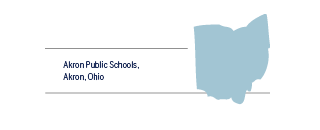

A group of fourth graders visits the Akron Art Museum.
PHOTO COURTESY OF AKRON PUBLIC SCHOOLS
The Essential ExperiencesSM program was developed as a collaboration between Akron Public Schools, a local philanthropic organization, and several community partner organizations to provide elementary students with a common meaningful experience outside the classroom. Students in preschool through fifth grade visit one of seven local cultural or historical organizations to participate in custom-designed educational programming directly connected to their classroom learning. Each school year, over 9,000 students deepen connections to their community, build skill sets through inquiry, and are exposed to career possibilities by participating in this program.
GAR Foundation is a local philanthropic organization deeply invested in the Akron community. The foundation helped the district create a comprehensive field studies program for all students with equity across buildings and to push inquiry-based learning. Site visits have included the Akron Zoo, Cleveland Museum of Natural History, Hale Farm & Village, Akron Children’s Museum, Stan Hywet Hall & Gardens, and Cuyahoga Valley National Park.
The district knew organizations were accustomed to hosting one-day field trips for other schools, but asked the institutions to create something new and unique for its students. The curriculum teams worked with partners to create meaningful pre- and post-experience activities.
Akron Public Schools is home to 20,627 students in 45 schools. Student demographics are: 46.49% Black, 28.63% white, 10.19% multi-race, 8.90% Asian or Pacific Islander, 5.58% Latinx, 0.16% Native American, and 0.05% Native Hawaiian or Other Pacific Islander.
Innovation: Prior to the grant, field trips at the elementary level were mostly teacher-driven. A student’s ability to attend outside learning opportunities may have been limited by barriers including funding or where a student lived, or where they attended school. Field trips just were not guaranteed for every child and every classroom across the district. The Essential ExperiencesSM grant and partnerships now ensure that every child in every elementary grade districtwide gets to have the same valuable real-world experience that strengthens their connection to their learning and their community.
Evidence of success: The GAR Foundation uses survey results from participating teachers and partners to gauge program effectiveness. It was able to collect 164 responses from teachers, teachers’ aides, administrators, and chaperones during 2019-20 (Year One). These surveys revealed that 75% felt that the experiences complemented classroom learning “very well” or “somewhat well,” and 86% of all teachers felt providers provided a positive environment for students.
During the 2021-22 school year (Year Three), survey responses were collected from 189 teachers. Results revealed that 83% felt that the experiences complemented classroom learning “very well” or “somewhat well,” and 85% of all teachers felt providers provided a positive environment for students.
Contact
Tricia Kelly, College & Career Academies teacher
tak46456@apslearns.org
www.akronschools.com
Community Schools


Students select new books provided by the Maryland Book Bank, a Community Schools partner.
PHOTO COURTESY OF MONTGOMERY COUNTY PUBLIC SCHOOLS
Community Schools serve as hubs that provide students, families, and community members with needed wraparound services. The district provides equitable services for the entire school community. Community Schools provide the physical health, mental health, academic, and extracurricular support services needed for students and families to flourish. The focus is on family and community engagement, culturally responsive relationship building, mental and emotional health, trauma-informed practices, restorative practices, and physical health and wellness, in addition to the district’s quality instruction.
The goal of Community Schools is to promote equity while prioritizing the critical needs of students and caregivers urgent to their well-being.
Innovation: Leveraging partnerships, the Community Schools have developed and implemented collaboration meetings to address student and family needs. Through partnerships with MANNA food, Capital Area Food Bank, and Community Farmshare, every community school now has either an onsite food pantry or a family market. From July to October 2022, more than 15,642 total people were served by markets alone. Community Schools also created diaper banks and distributed over 82,000 diapers and wipes. In addition to basic needs, the schools, through partnerships, provide after-school and wraparound activities such as the Maryland State Youth Soccer Association Let’s Play Program and the University of Maryland (UMD) STEM club taught by UMD professors. The district received a grant through the Maryland State Department of Education to initiate wellness trainer positions in the schools to focus on mindfulness, restorative practices, and ongoing support for mental health needs.
Evidence of success: The Community Schools began operation in 2019. During COVID, staff distributed food, created online workshops, contacted families for virtual learning, assisted in classrooms, developed partnerships, and engaged families. The 2021-22 school year was the first in-person year for Community Schools, and 2022-23 will be the second year. As the partnerships and services grow, the district has seen improvement in both qualitative and quantitative data, such as families reporting their needs addressed, increases in academic scores, and overall school climate improvement.
The Community Schools are funded by the Maryland State Department of Education (MSDE) Blueprint Senate Bill. Additional funds are received from the MSDE Leads grant. Funds for Community Farmshare were provided through the Montgomery County Council. Community Schools are also a part of the Title IV funding allocation.
Serving 161,102 students, Montgomery County Public Schools is the largest public school system in Maryland and the 14th largest school system in the U.S. Of the students within the school district, 150 languages are spoken, coming from 157 countries.
As of 2021-22, students included less than 5% Native Hawaiian, Pacific Islander, American Indian, Alaskan Native, Two or More Races, 14.1% Asian, 21.9% Black or African American, 25.3% white, and 33.4% Hispanic/Latino.
Contact
Amy Beal, Community Schools coordinator
amy_beal@mcpsmd.org
www.montgomeryschoolsmd.org
Climate Crisis Response
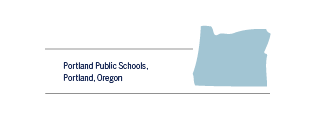
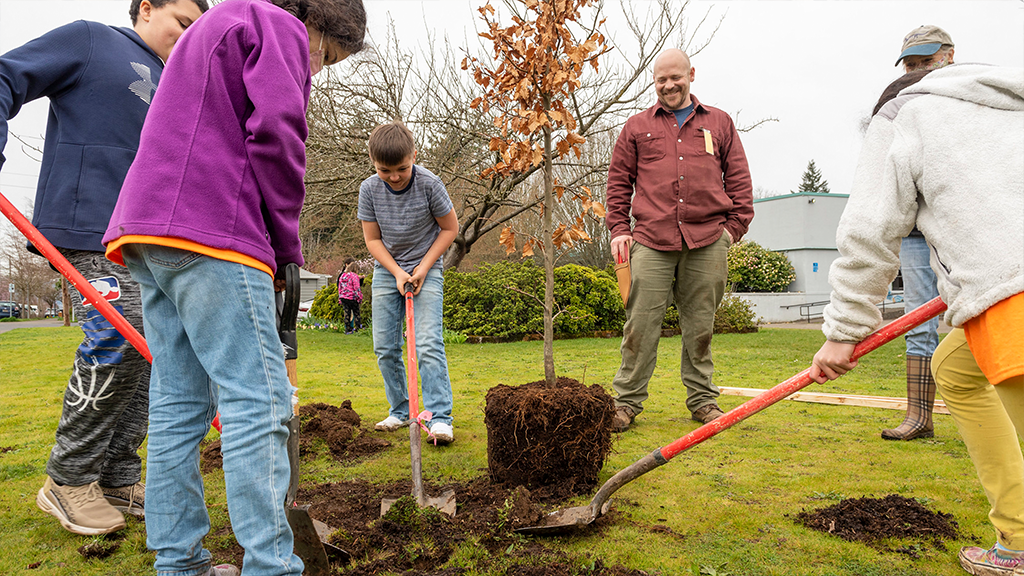
Students at Creston Elementary plant trees on the school campus as part of the district's climate response work.
PHOTO COURTESY OF PORTLAND PUBLIC SCHOOLS
Portland Public Schools is Oregon’s largest PK-12 school district, with more than 45,000 students in 81 schools. Portland students see how the climate crisis compounds individual and systemic injustices and inequalities, and they have demanded that adults, including school leaders, respond with action and urgency. The district’s climate crisis response takes two tracks. First, it is building sustainable and resilient operations, from the nutrition program to transportation systems and from where it procures supplies to how it builds and renovates buildings. Under the Climate Crisis Response Policy, passed by the school board in March 2022, the district will construct and renovate schools to be energy-efficient, resilient, and adaptable. All new buildings will be built without fossil fuel infrastructure, and fossil fuels will be phased out from existing buildings by 2050. The district will maximize carbon sequestration and other environmental benefits of school grounds and minimize greenhouse gas emissions from student and staff transportation. These and other changes are in service of a 50% emissions reduction by our district in the next eight years, and net zero emissions by 2040.
The nutrition program works with regional farmers and has phased in reusable serving materials, fully eliminated styrofoam and straws, and collected food scraps in all kitchens and many cafeterias.
The second track in the climate crisis response is student-centered. Students have been deeply involved in building modernization conversations, climate-related hiring decisions, and design decisions about their school grounds. Students routinely help depave their school grounds and maintain gardens, and even the littlest learners sort food scraps from other waste during mealtimes. Still others have served on our Climate Justice Youth Advisory, which has existed for the last two years.
Innovation: The act of codifying those commitments into a binding policy and implementing that work in earnest is an innovation that few other districts have accomplished. The policy spans emissions, electrification, education, student engagement, and climate justice, all in one policy. This allows school leaders to think intentionally about the relationships between these elements and to make holistic decisions.
Evidence of success: Building sustainable and resilient operations can be easily measured quantitatively. The district will use a Scope 1 and Scope 2 analysis to track all emissions associated with district-operated buses and fleet vehicles and building energy use from both natural gas and electricity. It also will track emissions associated with waste disposal (food waste, recycling, and landfill-bound garbage), which is defined as part of a Scope 3 analysis. In more traditional energy usage analyses, it already has seen measurable reductions.
As part of developing a climate-related curriculum, the district will be developing benchmarks to assess students’ comprehension more broadly. Evidence of students’ climate leadership is abundant locally. They have led periodic climate strikes, teach-ins, and marches. Students form the backbone of several local advocacy groups.
Contact
Will Howell, executive speechwriter
Mentor Center


Students spend time with University of North Dakota student-athletes.
PHOTO COURTESY OF GRAND FORKS PUBLIC SCHOOLS
Six months into the pandemic, Grand Forks Public Schools saw the learning loss and mental health challenges that the upheaval was causing for its students. The district sought funding to support both learning loss and mental health in a single facility that any secondary student could access.
From this concept, the Mentor Center emerged. The facility became what sociologists term a “third place,” a place in between school/work and home, somewhere that enriches lives and builds community. The drop-in center is open to all middle and high school students in the afternoons and evenings and provides free transportation, free food on-site, and take-home food as well. The teachers, tutors, and mental health/social-emotional learning (SEL) specialists serve as case managers monitoring grades, conducting check-ins, acting as liaisons and advocates with school and home, and becoming cheerleaders and trusted adults to students.
Innovation: The Mentor Center’s success required a willingness to reinvent as situations change. As the regular school year returned after COVID, it implemented new structures and homework requirements. It added case management to ensure all students got the attention they deserved. It continues to develop community partnerships, including working with the local mission to provide free take-home food and partnering with the local university’s occupational therapy department to provide pre-professional students direct service experience.
The populations drawn to the Mentor Center include a high representation of historically underserved students. In a city composed of 4% Black residents and a district with 9% Black students, 20% of the Mentor Center’s students are Black. While 3% of Grand Forks residents and 6% of GFPS students are American Indian, so are 15% of students at the Mentor Center. While 4% of Grand Forks residents and 9% of students are Hispanic, so are 16% of students at the Mentor Center. Nearly 20% of visits are by students who have experienced homelessness, and nearly 9% are by students currently in foster care or experiencing homelessness. While 18% of students are on an Individualized Education Plan (IEP), so are 30% of students at the Mentor Center.
The Mentor Center became a place where LGBTQ-identifying students feel welcomed and safe. As 61.6% of North Dakota’s queer youth “seriously consider attempting suicide” and 26.7% of queer youth have “no idea” who they might talk to about negative feelings, the center’s LGBTQ+-affirming environment is among its most significant efforts.
Evidence of success: The Mentor Center conducts quarterly grade checks as well as social-emotional learning surveys of students each semester. Nearly 80% of students state that the Mentor Center helped them pass classes they might not have passed otherwise. The benefits of wraparound mental health support are demonstrated in SEL assessments each semester. A full 78% of students stated they experienced a decrease in negative feelings, and 95% experienced an increase in positive feelings. Another 89% stated that the Mentor Center helped them be better able to persevere through setbacks, and fully 100% stated they had greater supportive relationships and could find a trusted adult at the Mentor Center.
Contact
Robin David, Mentor Center coordinator
rdavid130@mygfschools.org
www.gfschools.org
Oklahoma Aviation Academy


Oklahoma Aviation Academy students tour the University of Oklahoma Air Traffic Control Simulator Labs.
PHOTO COURTESY OF NORMAN PUBLIC SCHOOLS
Norman Public Schools has created a comprehensive science, technology, engineering, arts, and mathematics (STEAM) academy themed around aviation and aerospace. Working with the University of Oklahoma, Moore Norman Technology Center, and industry partners from the public and private sectors, the district is capitalizing on Norman’s geographic location and aviation history to create a program for high school students.
Starting with an inaugural freshman class in 2022 and with a vision to become a stand-alone academy, students also have opportunities for ancillary hands-on career and industry experiences that will transform the traditional education environment to authentically connect student learning to high-tech industry readiness.
Oklahoma has a critical demand for a highly skilled and trained workforce yet ranks near the bottom nationally in terms of STEAM education. This program provides industry-connected education pathways for Oklahoma students to connect directly with higher education, career tech, and industry partners, ensuring career readiness in the high-demand areas of aviation and aerospace.
The academy blends cutting-edge STEAM experiences, innovative industry connections, and world-class academics against a backdrop of aviation and aerospace. Additionally, students will be guided in the development of a culture of excellence that promotes intellectual, moral, civic, and performance virtues. This will occur through exposure to learning experiences designed to foster deep thinking and cultivate the critical skills needed to thrive in the 21st century. As students are empowered to take control of their personal journey toward a life of meaning and purpose, they will push toward the furthest boundaries of their potential.
Innovation: This program will provide industry-connected education pathways for students to connect directly with higher education, career tech, and industry partners, ensuring career readiness in the high-demand areas of aviation and aerospace.
Evidence of success: The Oklahoma Aviation Academy already has a freshman class of 80 students attending class at the Max Westheimer Airport in Norman. Additionally, plans are underway to construct a stand alone facility on the airport grounds that could house up to 800 students.
The district has received overwhelming support through grants from partners such as Boeing and the Norman Economic Development Coalition. This support allows the district to move forward with plans for the construction of the facility and to make the program and curriculum available virtually statewide.
Norman Public Schools has roughly 16,000 students in a community of 100,000 people. Norman is a college town, home to the University of Oklahoma, and also a suburb of Oklahoma City.
Norman Public Schools’ student demographics are 55% white, 16% Hispanic, 14% multiracial, 7% Black, 5% Native American, and 3% Asian American. About 52% of students are eligible for free or reduced-price lunch.
Contact
Chelsey Kraft, communications specialist
ckraft@normanps.org
www.normanpublicschools.org
Virtual Advanced Preparation Program

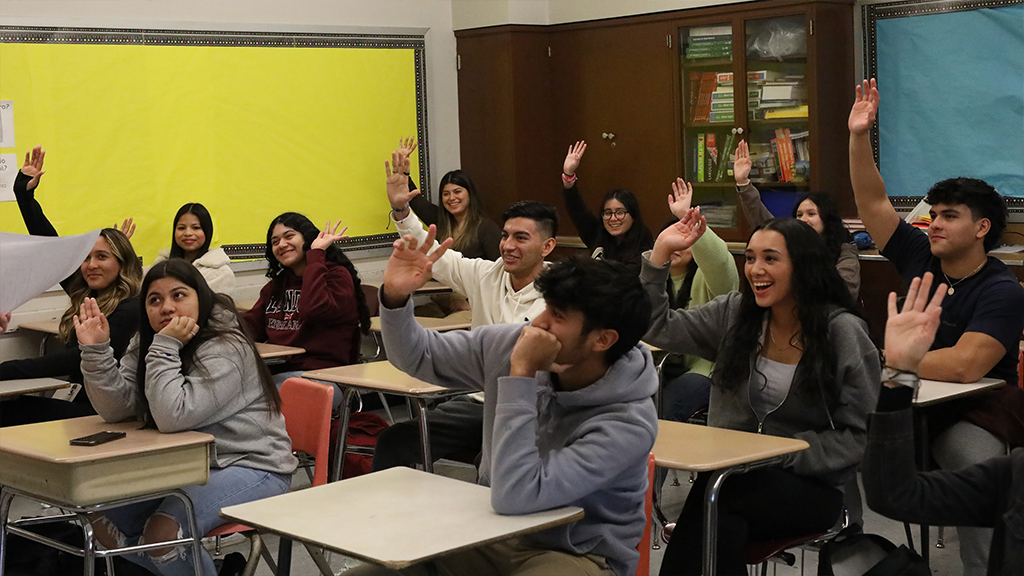
By increasing the relevance and value of student course selection, the South Huntington School District expanded the pool of students participating in advanced courses.
PHOTO COURTESY OF SOUTH HUNTINGTON SCHOOL DISTRICT
This program was created to provide support to those students who otherwise would not see themselves as being capable of advanced coursework. This process, which starts at the earlier grade levels, needed to be structured in a way that parents, students, and teachers would all feel comfortable in providing the best opportunities for all students. This is especially true with those students of lower socioeconomic levels as well as students of color.
As district demographics continued to change, it became apparent that many students of color did not participate in Advanced Placement (AP) courses or advanced coursework that led to college credit. The need to expose all students to some level of advanced coursework pushed the district to reevaluate its processes on how to identify students at an early age who would be capable of potentially completing AP courses or college-sponsored courses at the high school.
Innovation: The district has been able to lessen the gap and disparity between all students as it relates to advanced-level coursework. The high school employs a blended model for academic support using Chromebooks that provide access to teachers and other students combined with summer workshops. Students of various ethnicities and ability levels were provided the opportunity to complete AP classes at the high school level.
Students at the intermediate grade levels were identified as having the ability to complete such work. Added classes, plus the addition of a Student Center lab, before- and after-school support sessions, and parent meetings and conferences, allowed for students to be further supported in their pursuit of advanced courses.
Through these efforts, students felt more empowered to continue to push themselves both academically and socially, creating an engaging school community where all felt supported and nurtured.
Evidence of success: There has been a 42% increase in the amount of AP exams given over the last 10 years; a 34% increase in the total number of students taking AP courses/exams. The number of Black students taking exams has doubled in the last five years, and 30% more Hispanic students took AP exams in the last five years. About 50% of students are leaving high school with six or more college credits.
South Huntington benefits from Title IA federal funds based solely on levels of poverty (percentages of students benefitting from free or reduced-priced lunch). Additionally, approximately 9% of the student population are English learners. The district has been successful in, and continues to focus on, closing the achievement gap within the diverse student population. Over 25% of the student body, regardless of socioeconomic status, participates in the AP program. In addition, 30% of the graduating class was recognized with AP scholar designation.
Contact
John Murphy, assistant superintendent for curriculum and instruction
jmurphy@shufsd.org
www.shufsd.org
Education Academy


An Education Academy student conducts a small group lesson for younger district students.
PHOTO COURTESY OF BALDWIN UNION FREE SCHOOL DISTRICT
The goal of the Education Academy is to increase the pool of diverse candidates and to assist students in developing the knowledge, skills, and dispositions necessary to become effective and caring teachers in an ever-changing society. Students are prepared to become reflective, lifelong learners. Required courses are linked with field experience, interdisciplinary instruction, and projects. Academy electives provide career focus to existing curriculum to enhance the development of the skills required for the chosen profession. Extracurricular clubs, shadow days, and internships provide real-world experiences to help align academic pursuits to the world of education.
The district started the academy in 2017, collaborating with Molloy College. Baldwin High School students take credit-bearing courses toward a teaching degree and gain hands-on K-12 teaching experience within Baldwin schools. The Education Academy maps a direct path for students to successfully transition from high school into Molloy as sophomores and back to Baldwin to complete their student teaching requirements in their senior year of college.
Students enroll in their freshman year, earn college credit at reduced tuition, and gain hands-on teaching experiences during their senior year of high school. They ultimately enter Molloy College as sophomores.
The required courses for the Education Academy are linked with field experience, interdisciplinary instruction, and projects, while electives provide career focus to the existing curriculum to enhance the development of the skills required for the teaching profession. Courses include contemporary topics in education, mindfulness, introduction to teaching, as well as critical issues in education and foundations of education—both of which are dual enrollment courses with Molloy College.
Innovation: This program addresses important issues in education: teacher shortage, diversity in the profession, and college debt. By allowing students the opportunity to start a career path before graduating high school, they will save on the costs associated with college and job training. The Education Academy is a great way for students to test the waters and determine if teaching is what they want to do for the rest of their lives. Some students may think they want to pursue a particular career, but after participating in an academy, they learn that it may not be the best fit before attending a four-year school. This opportunity helps students decide. A change of major once enrolled in college can delay graduation, cost credits, and ultimately lead to more debt.
Evidence of success: As of today, more than 75 students are enrolled in the Education Academy, and this number is expected to grow over the next few years. It started with just a few students, and each year has seen a steady rise.
The Baldwin community is a diverse town that prides itself on being unique and forward-thinking. District student enrollment is 47% Black, 32% Hispanic, 12% white, 5% Asian/Alaska Native/Pacific Islander, and 4% multiracial.
Contact
Mary Furcht, public information officer
furchtm@baldwinschools.org
www.baldwinschools.org
Whole Child Supports

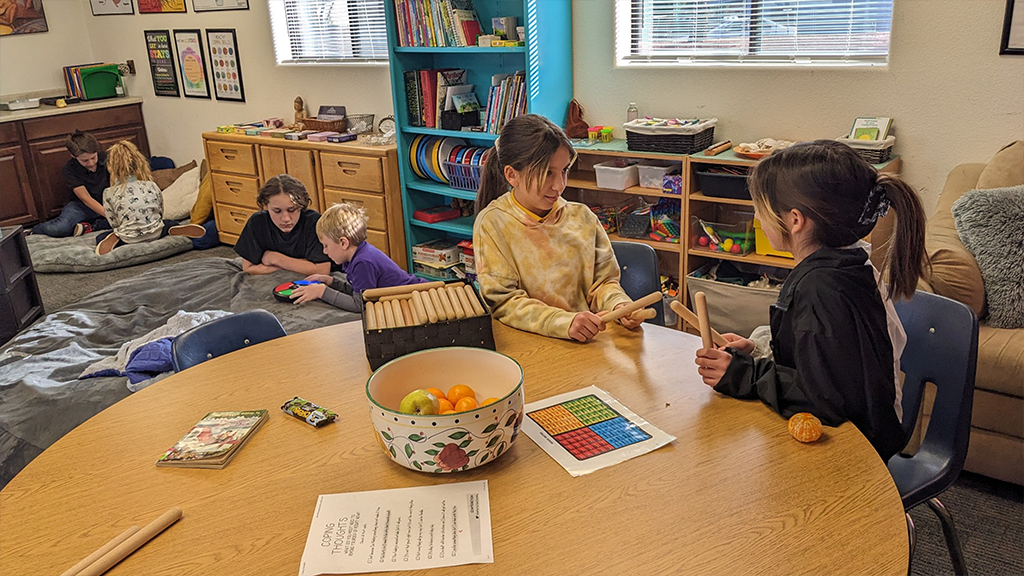
Students in a Focus Zone space work together to learn coping skills and “resetting” before returning to the classroom.
PHOTO CREDIT: BARB DAHER FOR COTTONWOOD-OAK CREEK SCHOOL DISTRICT #6
The Whole Child Support program is based on research from the Icelandic Model of Prevention for whole child supports. It was initially designed to address chronic absenteeism, serious discipline issues, and reoccurring behaviors that were often sending children home daily.
Through the school board’s leadership, the district obtained a one-year pilot grant to implement a mindfulness program at Cottonwood Elementary School. That was the beginning. Strategies implemented were beneficial in reducing negative behaviors and increasing student engagement and attendance. The board unanimously charged the administration with district reorganization to ensure that schools provided an environment focused on the “whole child.”
The school board built an inclusive culture focused on student social and emotional support. The district has layered systems of student supports and uses restorative practices; ACEs (adverse childhood experiences) trauma-informed staff, and expanded after-school activities. The district has gone from .75 counselors districtwide in 2017 to 10 student support specialists currently, all through private grant funding.
Innovation: The district began by creating a multitiered system of supports. Then it instituted the Focus Zone program and began educating and training teachers in the work of Dr. Bruce Perry and the brain science behind trauma and neglect. It also surveyed students to see what activities would appeal to them as part of a robust after-school program. The final step was creating an engaging hands-on learning environment for high school students at risk of dropping out.
With Focus Zones, students are given an opportunity to go to a safe space, slow down, and think before they respond. This creates space between stimulus and response. Focus Zones also include information for students on ways to calm themselves through deep breathing exercises, listening to music, or doing yoga. They practice techniques for making better choices through role-playing with teachers and peers and learn to turn negative impulse behaviors into positive choice behavior.
Evidence of success: The district has documented significant decreases in student absences and suspensions over the past five years. Between August 2016 and April 2018, there was an overall decrease in discipline incidents, and suspension incidents decreased. This is an overall decrease of 38%, which means children with significant behaviors are remaining in the educational environment that the district can provide. For the month of October 2022, there were 1,762 visits to the Focus Zones districtwide.
Cottonwood-Oak Creek School District is a preK-12 district in rural, central Arizona, serving approximately 1,900 students, of which 70% qualify for free and reduced lunch. About 15% of the student population qualifies for special education services under IDEA guidelines as students with disabilities. The district has seen an increase in nontraditional families, often, with extended family members such as aunts/uncles or grandparents raising children. The Hispanic population is about 40% of student enrollment. Schools have a 33% mobility rate with students moving from school to school frequently throughout the year due to housing instability.
Contact
Tricia Winters, executive assistant to the superintendent
pwinters@cocsd.k12.az.us
https://www.cocsd.us
Harwood Harkness Initiative
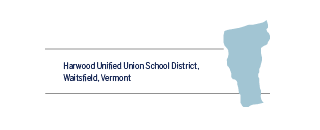

Harwood Union High School students participate in a Harkness discussion, asking probing questions and working together to delve into
complex ideas and make meaning of their investigation.
PHOTO COURTESY OF HARWOOD UNIFIED UNION SCHOOL DISTRICT
The Harwood Harkness Initiative was established in 2016 with a $100,000 grant from the Rowland Foundation. The program, initially led by now retired history teacher Katherine Cadwell and a cadre of high school faculty and students, aims to transform teaching and learning by infusing the Harkness pedagogy of student-driven inquiry into classroom culture and practice.
The initiative amplifies student voice, encourages a diversity of perspectives, equity, and inclusion in classroom culture, and develops the skills of civil discourse throughout the school. The Harkness pedagogy places students at the center of the educational process. The skills of questioning, valuing different perspectives, and learning how to disagree respectfully and work collaboratively are the essential skills students need to acquire if democracy is to remain healthy, vital, and strong.
Innovation: This program seeks to transform traditional classroom practice from the ground up by creating student leadership opportunities and fostering student/teacher partnerships. Students and teachers created the model of classroom transformation together. Student leaders addressed the faculty at the beginning of the 2017 school year, calling for teachers to create a classroom culture based on mutual respect, trust, and collaboration. They expressed their frustration with the existing school and classroom culture, and they wanted the faculty to develop systems to hold students accountable for their behavior. As a result, schoolwide norms for classroom behavior were developed jointly by students and teachers. Moving forward, every aspect of our model to infuse Harkness into classroom practice has been grounded in the power and importance of student-teacher partnerships.
High school students can enroll in a unique “Harkness Leadership Class” where students gain leadership skills and learn the essential components of inquiry learning and classroom dialogue; this course is co-taught by a teacher and two students. Harkness student leaders go into classrooms to train their peers in the skills of Harkness, and they facilitate discussions in middle and high school classes.
Evidence of success: Since its inception in the 2016-17 school year, the Harkness Initiative continues to expand. In the 2017-18 school year, 12 teachers and 12 student leaders were trained in the Harkness pedagogy. All ninth-grade English and history teachers received intensive instruction in Harkness. By the end of the 2018 school year, all ninth-grade students participated in Harkness discussions as part of their academic program. In the 2018-19 school year, 16 additional teachers and 15 students joined the cadre and were trained in Harkness. Teachers of sophomore students then began to integrate Harkness discussions into their classes. In 2018-2019 and 2019-2020, 15 more teachers in different disciplines received Harkness instruction. Beginning in 2018, the school administration supported the creation of a Harkness professional learning community. Coached and encouraged by teachers and students, the school administration began to use the Harkness model in faculty meetings to discuss issues of race, class, and privilege.
Contact
Michael Leichliter, superintendent
mleichliter@huusd.org
https://huusd.org/
HONORABLE MENTIONS
The Hospitality Academy
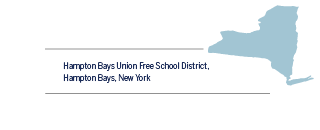
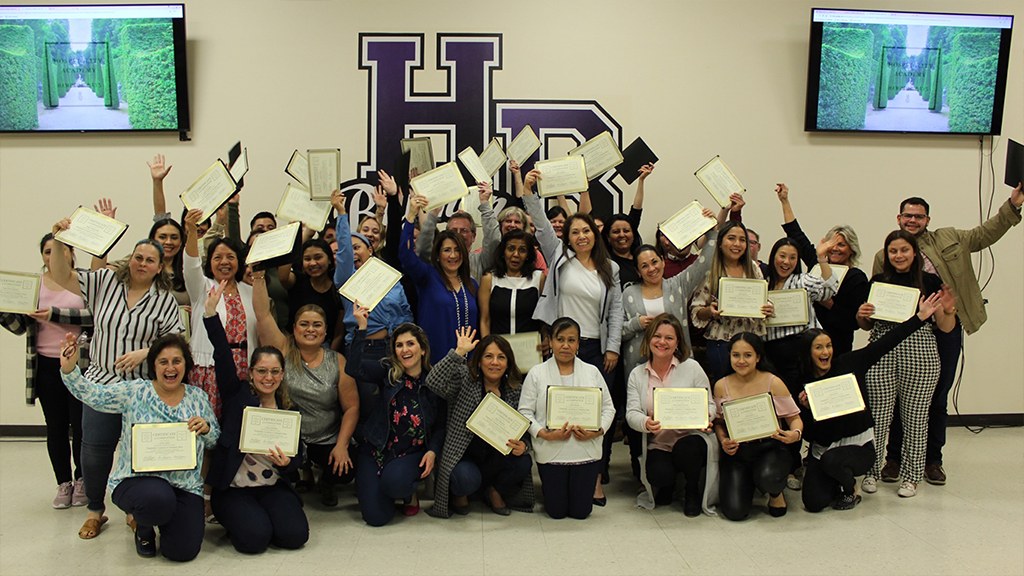
Graduates of the Hospitality Academy celebrated their accomplishment with academy staff and the Suffolk County Commissioner of Labor, Rosalie Drago.
PHOTO COURTESY OF HAMPTON BAYS UNION FREE SCHOOL DISTRICT
The Hospitality Academy is an adult education program that complements the district’s K-12 career and technical education program. Hampton Bays Union Free School District is located on the east end of Long Island in the Hamptons region. Despite being in one of the most desirable tourist destinations in the world, the district’s student population is 64% economically disadvantaged. The school board understands that economic disadvantage is an at-risk factor for student achievement, so it partnered with the Suffolk County Department of Labor and the Canoe Place Inn, a restored historic inn and resort in Hampton Bays. The partnership provides a 10-session, five-week training program in hospitality and tourism to adults in the community. It culminates in a job fair with the Canoe Place Inn and other local hospitality and tourism businesses. The program is free to all participants, and in addition to all class materials and speakers being provided, the academy offers real-time Spanish-language translation, dinner, and child care for school-aged children to remove logistical obstacles.
Innovation: According to the New York State Department of Labor, there has been a 61% increase in the number of job openings on Long Island. As the competition for skilled workers increases, ensuring a pool of trained and committed candidates in the hospitality sector is critical for the future of the economy of the Hamptons. This approach brought diverse parties to the table with the goal of increasing the number of talented and committed job candidates in an increasingly competitive job market. The Suffolk County Department of Labor was committed through its funding of a $55,000 grant. The Canoe Place Inn management team provided technical expertise and access to current industry leaders who were engaged as keynote speakers in each class. Finally, the district committed teacher and staff time in the evening for instruction, food service, translation, and child care support. Ultimately, this program provided a solution to two fundamental problems — (1) employers identifying a limit to the number of qualified and committed job candidates currently seeking employment, and (2) training and job prospects with career pathways for a community with a significant percentage of individuals living below the poverty line. When families are more economically stable, the prospects for their children to have a successful and stable education are improved.
Evidence of success: The Hospitality Academy completed its first year in 2022. The resulting job fair in April 2022 resulted in 23 businesses being presented and more than 75 individuals being interviewed and considered for local jobs. Currently, at Canoe Place Inn, and other hospitality businesses in the region, there are several employees who are graduates of the academy, including two events supervisors, a director of housekeeping services, and a front desk manager. Feedback from the Suffolk County Department of Labor included an endorsement of the academy’s focus on dignity in job training and workforce development. Participants were given resume and interview prep to empower them for a successful interview.
Contact
Lars Clemensen, superintendent
https://www.hbschools.us
https://www.hbschools.us/community/hospitality_academy
Micro-credential Pathways for Teacher Leaders

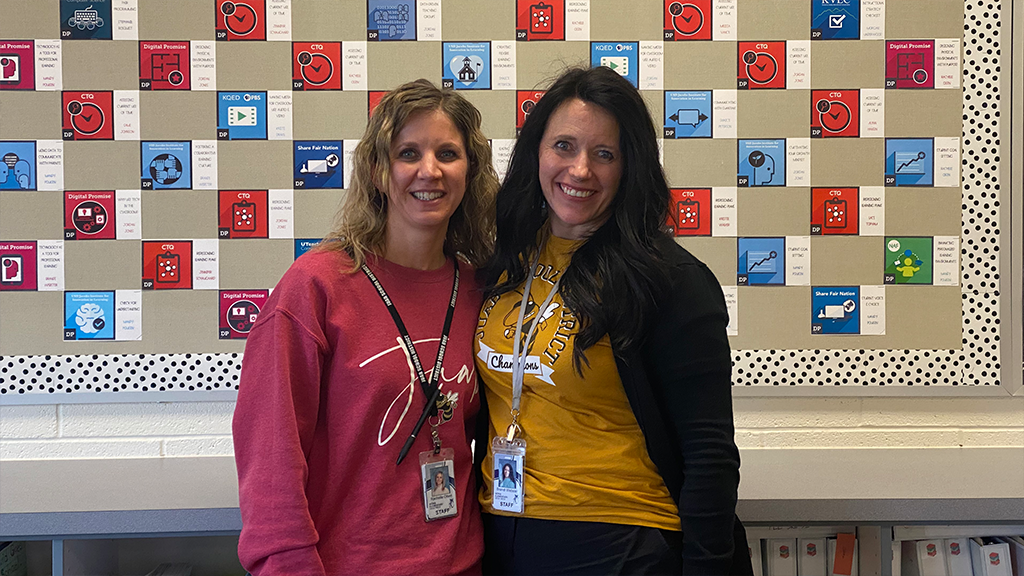
Teacher Rachelle Olsen and Principal Brandi Webster, Mona Elementary. Olsen’s teacher-leader pathway focused on data-driven decision-making.
PHOTO COURTESY OF JUAB SCHOOL DISTRICT
Teachers in the Juab School District use micro-credentials as a system to support professional learning. In 2016, Utah was exploring the concept of merit pay for educators. The district wanted a system that would celebrate and reward learning, not punish educators. It recognized that in the efforts to personalize learning for students, many teachers were creating systems that they had never experienced as learners. This program was created to model personalized, competency-based learning and help teachers progress in their desire to provide personalized experiences for students. The district wanted to create and support teacher leaders, educators who want to stay in the classroom but lead out in their practices. It partnered with Digital Promise to craft a micro-credential pilot. This program was created in 2016 as a teacher retention strategy.
Seven years later, micro-credentials are part of the fabric of the district. Cohorts are formed to support credential earning. Micro-credentials are integrated into instructional coaching and new teacher support systems. Teachers and administrators are encouraged to choose a micro-credential that highlights strengths or challenges them in an area of growth.
Educators can work with an administrator to design a teacher-leader pathway. This allows each educator to become a specialist in a defined area of personalized learning.
Innovation: Teachers often cite the lack of time as a barrier to professional learning. Micro-credentials are action-research and job-embedded. This provides educators with a system in which professional learning is not “one more thing” to make time for but instead built into the existing school day. Students are part of the professional learning experience as teachers often use classroom artifacts and student reflections.
In addition, traditional professional learning often lacks impact. A sit-and-get model does not lead to teacher improvement. The micro-credential system allows teachers to create goals around their individual problems of practice. Teachers select micro-credentials aligned to their job context, the district mission and vision, and Utah’s Effective Teaching Standards.
Evidence of success: Since 2016, educators have earned nearly 700 micro-credentials. There are currently 23 teacher leaders and 85% of educators have earned at least one micro-credential. Both new and veteran teachers engage in the program and share their excitement at learning skills tied to their individual needs. Teacher leaders facilitate school and district-level professional learning opportunities for teachers.
Civic and Cultural Learning Experiences


Malverne High School students used lessons learned about civic engagement, cultural respect, and productive conversations to have a street renamed.
PHOTO COURTESY OF MALVERNE UNION FREE SCHOOL DISTRICT
The Civic and Cultural Learning Experiences initiative was created to engage students in demonstrating more profound respect and empathy for people’s cultural similarities and differences. In so doing, they could create lasting change in their world.
On the elementary level, the program begins with The Growth Project, where students and teachers engage with a social justice text each month and discuss the cultural and societal impacts of the issues. Classes have a monthly read-aloud that explores diverse cultures, experiences, and perspectives as they tackle ideas of racism, equality, and social justice.
The program has included a K-12 course of study on Anne Frank and Dr. Martin Luther King Jr. Students focus on the goal of empathy and stories of resilience as they read the children’s book, Martin and Anne: The Kindred Spirits of Dr. Martin Luther King, Jr. and Anne Frank.
Last year, the students participated in a “What is in a Name?” project. The district’s K-2 primary school was on a street named after a leader in the Ku Klux Klan. Paul Lindner was an early settler of Malverne and owned the land on which stands Malverne Primary High School, also originally named after him. Malverne High School students led community forums, spoke at school board meetings, and attended Village Hall meetings to speak about the need to change the street’s name. Despite visible opposition, these students persevered, often returning to Village Hall to present further research on the issue. This project resulted in the Village Board voting to change the name. This project was empowering for students and reinforced the goals of the program.
Innovation: Each day, Malverne is faced with the challenge of educating students from diverse backgrounds to understand history and academics and their roles in society. This program was a direct result of the need for students to be heard, seen, and valued in the wake of the killing of George Floyd and the subsequent protests that summer. With quarantine ending and activism heating up, that summer presented a unique opportunity to pivot towards a truthful philosophy of education or to stay with the status quo. The Malverne innovation was to grow with the needs of the community and its students.
Evidence of success: The program has been running since the late spring of 2020. Students have developed the skills to have conversations about race, gender, or belief differences and think about how to make those conversations productive. On the secondary level, there has been an increased club enrollment in the Gay-Straight Alliance, service learning, and community action clubs, as well as more focus on those clubs being centered on understanding and taking a role in creating a culture of understanding.
Contact
Jason Mach, supervisor of humanities
jmach@malverneschools.org
http://malverneschools.org
Career Pathways Career and Technical Education

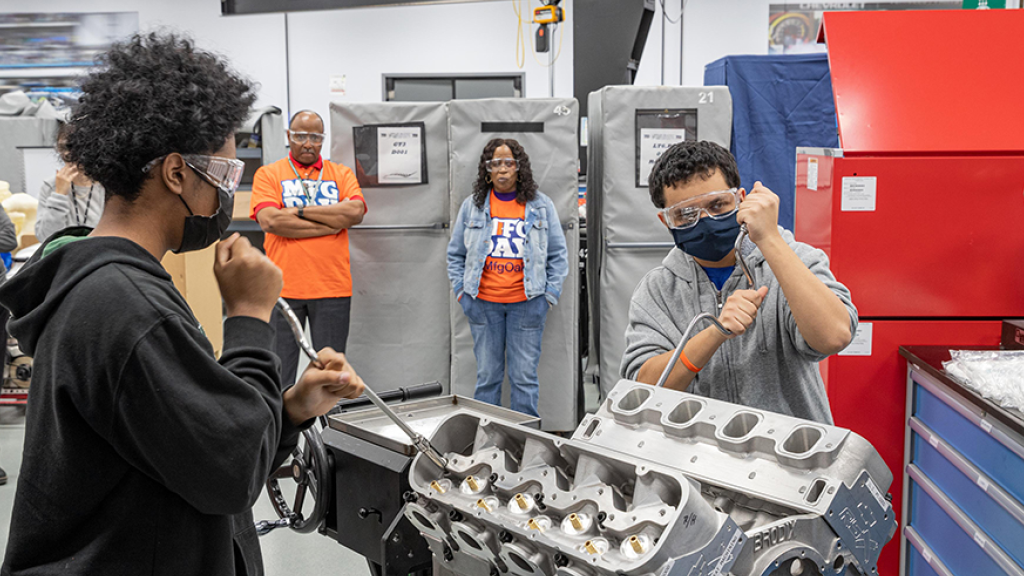
On National Manufacturing Day, a Pontiac High School student gets a lesson in engine building at the General Motors Performance and Racing Center.
PHOTO COURTESY OF THE PONTIAC SCHOOL DISTRICT
The Career Pathway program gives high school students the opportunity to explore and immerse themselves in some of the most desirable and competitive job fields available. Students select a pathway and are enrolled in courses that will prepare them for the future in their chosen industry. Students work directly with industry experts and gain job experience with Fortune 500 companies and other corporate leaders in the field. Coursework is conducted on-site at Pontiac High School, with internship opportunities available as students advance through the courses. Upon graduation, students have enough knowledge and practical experience in their field to transition directly into a job or continue their education in the field in a collegiate or trade setting.
Pathways include certified nursing technician, patient care technician, biomedicine, engineering and manufacturing, information technology, business and finance, JROTC, and hospitality and tourism.
Innovation: Through the creation and growth of these pathways, the district has seen a dramatic increase in student engagement across the high school. Additionally, grades and graduation rates are improving. Being able to see themselves in a career with a future gives students confidence and increases the importance of all coursework. Students in the pathway programs have gained important presentation and communication skills that will be relevant for them no matter what career they ultimately choose.
Evidence of success: The first pathway was the patient care technician pathway, which began in 2016. Approximately 160 students have completed and graduated from the program. Those students have gone on to obtain jobs in hospitals, nursing care facilities, and private care facilities as well as to pursue nursing and other medical degrees in college.
Due to the closures during the pandemic, other pathways are still completing their first cohorts. Students are earning paid internships and making strategic long-term plans as they prepare for graduation. The district has seen consistent increases in students joining the pathways programs. Overall, approximately 500 students enrolled in pathways at the high school.
Additionally, the district has taken elements of the experiences found in Career Pathways and expanded them to include upper elementary and middle school students. One example is the fifth-grade project where students created, promoted, directed, and hosted their own podcast under the direction of our communications and media team.
Contact
Heidi Hedquist, communications
heidi.hedquist@pontiacschools.org
www.pontiac.k12.mi.us
www.pontiac.k12.mi.us/programs/dual-enrollment-career-pathways
Intentional Collaboration
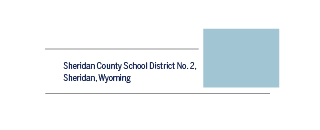

District administrators, PTO members, trustees, and the building principal participate in a collaborative feedback session at Meadowlark Elementary.
PHOTO COURTESY OF SHERIDAN COUNTY SCHOOL DISTRICT NO. 2
Like many education communities, Sheridan County School District No. 2 is committed to collaboration. But the district realized that being committed to collaboration was not enough. It needed a deeply embedded philosophy to improve at a faster, more consistent pace. A philosophy of focus on people, not programs, emerged. This resulted in a three-pronged approach. The first prong relies heavily on teachers developing, refining, and evaluating the effectiveness of their curriculum. Teachers were allotted schedules, time, and permission to delve into what their students need to learn at each grade level and in each content band.
The second prong is grounded in the culture of being collectively responsible for all students. Teachers removed barriers that assigned students to particular classes and began focusing on how each child’s needs could be met. Finally, evidence of student learning is at the forefront of developing people. Teachers began looking for ways to improve their craft. While many educators see the value in using assessment data to determine next steps for students, Sheridan teachers began seeking efficiency by collectively understanding the practices that proved to have the greatest impact on student learning. Teams continue to root out practices that do not produce results and capitalize on practices yielding high results.
Innovation: The district began its journey of philosophical change in 2006. The leadership team began to study the literature generated by the professional learning community (PLC) architects. All district buildings dove into the PLC collaborative philosophy and framework. Each principal was encouraged to adhere with fidelity to PLC fundamentals while maintaining a unique school culture.
Every staff member needed to understand how people accelerate student learning. The leadership team began empowering teams to develop their own tools to design systems for addressing four critical questions: 1. What do all students need to know and be able to do? 2. How will we know if they have mastered these goals? 3. What will we do if some students do not achieve proficiency after we’ve taught it? 4. What will we do if some students already demonstrate proficiency?
The process of development of these tools generated revolutionary learning for staff and leaders alike. Now, teachers were having in-depth conversations about learning, rather than teaching. Teachers could be heard seeking advice from colleagues across the hall because of the results they obtained on assessments created by their own team. Teachers began talking about specific steps a student needed to take to move forward in their learning progression.
Evidence of success: Since the origins of the shift in 2006, the district has seen a steady increase in student achievement. District students have achieved Wyoming’s highest aggregate performance on the state assessment in English language arts, math, and science every year since 2013. This includes all students tested in grades three through 10. In 2022, district students outperformed the state average by over 10 points in 17/19 tested areas on state assessments.
Contact
Kristie Garriffa, assistant superintendent
kristie.garriffa@scsd2.com
http://scsd2.com
Engineering Design & Development (EDD) & EDD Presents Showcase
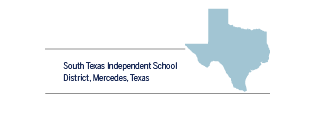
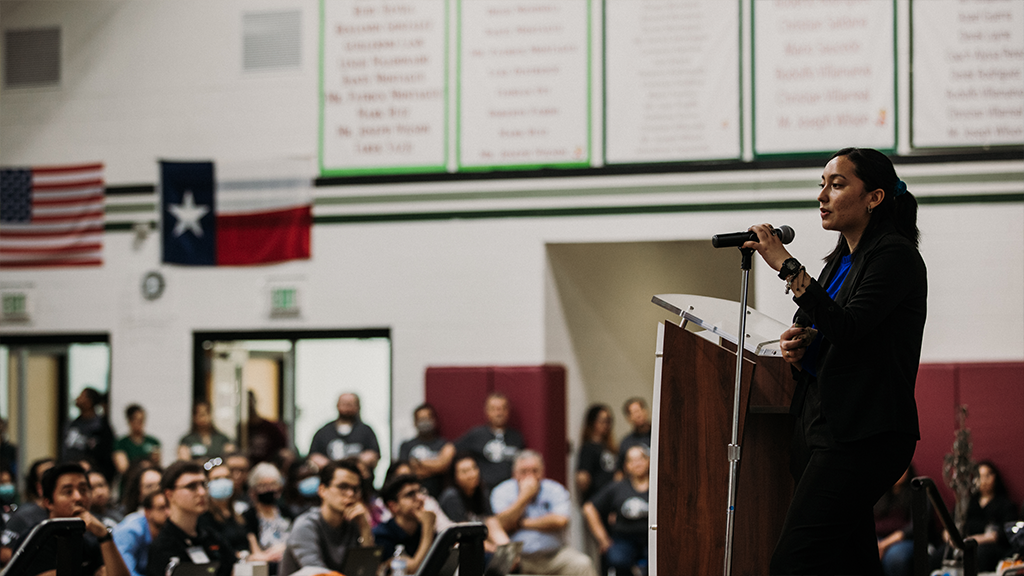
Judges and the campus community listen as a Science Academy senior presents her project.
PHOTO COURTESY OF THE SOUTH TEXAS INDEPENDENT SCHOOL DISTRICT
In 1993, the South Texas Independent School District Science Academy (The Science Academy of South Texas at the time) established the Engineering Design & Development (EDD) capstone course for the school’s first graduating class. South Texas ISD is comprised of seven magnet schools throughout the Rio Grande Valley. It is the only all-magnet school district in the state.
The original model had students present their projects in their respective EDD classes for only their peers and instructor. With a limited audience, students were also limited in the feedback received on their solutions. In 2014, the engineering faculty and administration expanded it into a larger campuswide event. Students began presenting to an audience that included underclassmen; all campus faculty, staff, and administration; outside judges with engineering and technical backgrounds; and even the seniors’ parents. The judges evaluate the projects based on a set of specific criteria, including the prototype, testing results, and presentation.
The campus also integrated into the event an opportunity for the top three teams from the preliminary round to present a second time in front of all attendees (students, faculty/staff, judges, and guests) in one venue and for the student body to cast their votes for a Students’ Choice Award winner. The campus also brings in keynote speakers and offers live music during downtime.
Innovation: After more than 20 years of having seniors at the campus complete the course and associated project, the engineering department recast the event to engage the entire campus community and call on outside engineers to serve as judges and offer expertise and feedback to the next generation of engineers.
Including underclassmen in this event solved the issue of preparing each year’s seniors from scratch for the project, as they had an opportunity to see multiple years of presentations to prepare. This early exposure and networking gave students a leg up on understanding the process and finding inspiration for the type of problem to pursue.
Evidence of success: In 2000, Project Lead the Way, an organization that empowers students across the U.S. to develop in-demand, transportable knowledge and skills through pathways in computer science, engineering, and biomedical science, adopted EDD as its first engineering course.
The Science Academy has continued to grow and expand the course and associated learning experiences.
The campus has great participation from the community, with faculty from local universities and colleges volunteering their time to sit in on and judge presentations, along with alumni and other business people lending their expertise. Local universities also commit scholarships towards the event.
Contact
Amanda Odom, administrator for public relations & marketing
amanda.odom@stisd.net
https://www.stisd.net/

Share this content